Kandy washing machine does not spin or drain water
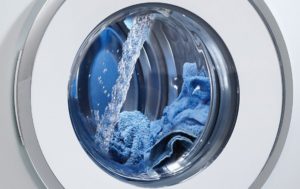 What should I do if the washing machine stops during a cycle with a full tank and does not want to continue working? The reasons for such “freezing” of equipment can be different. Let's figure out why the Candy machine doesn't squeeze out or drain the water, what to do in such situations, what to check first.
What should I do if the washing machine stops during a cycle with a full tank and does not want to continue working? The reasons for such “freezing” of equipment can be different. Let's figure out why the Candy machine doesn't squeeze out or drain the water, what to do in such situations, what to check first.
Why did the equipment fail?
If the washing machine is old enough, then such a “symptom” as “freezing” with a full tank of water and a reluctance to drain the liquid can indicate a breakdown of almost any element. You will have to inspect the components and parts one by one in order to identify the cause of the malfunction. When the machine has been in use for less than two or three years, it is better to focus on the typical “diseases” of Candy equipment. First of all, you should check the washer's garbage filter.
Most often, the washing machine cannot get rid of water in the tank due to a clogged drain system.
The easiest way is to check the trash can. Perhaps, during the next wash, a foreign object got in there, for example, a baby sock or a handkerchief. If you haven't cleaned the filter in a while, it may become clogged with debris, threads, lint and hair.
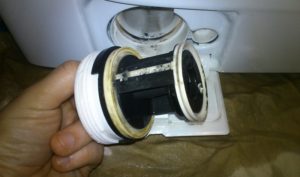 A crumpled scarf or sock stuck in the pipe or clogged the garbage filter will prevent the water from draining. Therefore, it is logical that the machine will not be able to start spinning.
A crumpled scarf or sock stuck in the pipe or clogged the garbage filter will prevent the water from draining. Therefore, it is logical that the machine will not be able to start spinning.
In any case, you will have to drain the water from the tank yourself. What to do first? First, prepare a low, roomy bowl to collect the liquid. Carefully tilt the machine back and place a container under the body. Secondly, cover the floor around the machine with dry rags.
Next, you can unscrew the filter plug.Remove it gradually, first by a quarter, then halfway, then remove it completely. Collect all the soapy water in a bowl. Then inspect the filter element and drain hole. If you find a “lost” sock or a lump of garbage, you can assume that the cause of the breakdown has been eliminated. When there is no blockage in this place, you will have to check other elements of the washing machine.
You need to inspect the following parts of the Kandy washing machine:
- drive belt;
- drain pump;
- tachogenerator;
- electric motor;
- motor brushes;
- control module.
If any of these elements fail, the automatic machine will not be able to drain the water and begin spinning. The test should begin by moving from simple to complex.
Pay special attention to the belt
Inexpensive Candy models have two weak points - the engine and the drive mechanism. Both the design itself and the quality of these parts are not delightful. According to statistics, already in the first year of operation, one out of 14 washing machines begins to have problems with the motor, drive belt or tachometer.
It is precisely because of the failure of these elements that the machine may stop with a full tank of water and not begin spinning. It is better to start diagnostics with the drive belt - it is the easiest to get to. The algorithm of actions will be as follows:
- Turn off the power to the washing machine, close the inlet valve, disconnect the drain and inlet hoses;
- place the washing machine so that you have free access to all sides of the body;
- Unscrew the bolts securing the rear wall, remove the panel;
- inspect the internal components of the machine.
After removing the back panel, you can see a large and small pulley, a belt stretched between them, a tank, an electric motor, a heating element and a drain pipe.
First, pay attention to the drive belt.Perhaps he even fell off the “wheel” and is lying below. Then it will immediately become clear why the machine stopped working.
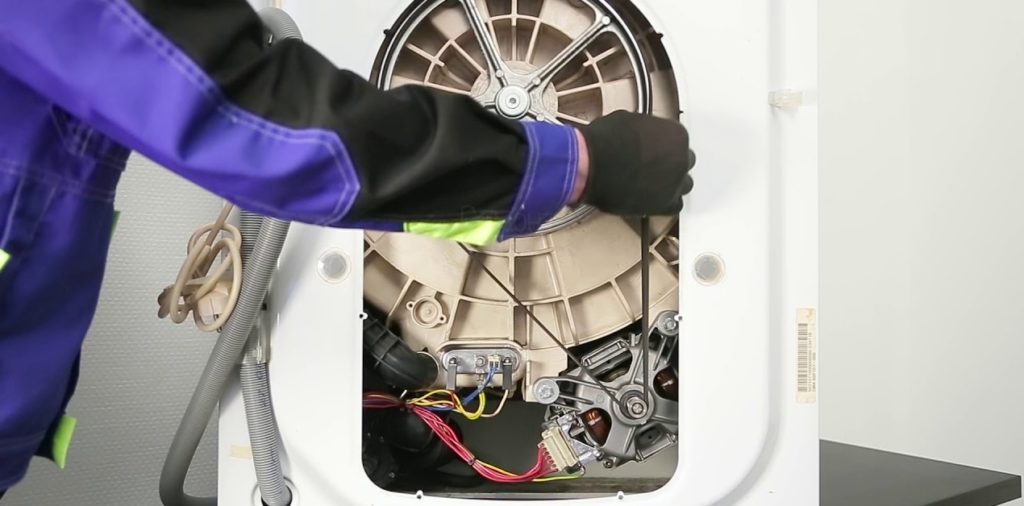
If the belt is tight, rotate the large pulley first to the right, then to the left. The “wheel” must rotate with a certain force, and the elastic tension must be sufficient. If it bends or moves, it will have to be replaced.
A poorly tensioned drive belt does not allow the motor to spin the drum to the required speed. The washing machine cannot spin. This leads to a system error that causes the machine to freeze in the middle of the cycle.
Some craftsmen on the forums suggest not changing the belt, but saving money by tightening the engine mount to move the pulley a few millimeters. Due to this, the desired degree of elastic tension is achieved. However, this solution only saves for a few months, and then the problem recurs.
Take a closer look at the pump
Next you should check the drain pump. The Kandy washing machine pump is also not very reliable, so it may well fail after several years of use. In addition to the “burnout” of the part, failure is caused by debris clogged inside the element or wound around the impeller.
Installing a washing machine at a great distance from the sewer causes faster pump failure. The length of the drain hose should not exceed three meters, only then the load on the part will be acceptable. If the “sleeve” stretches for 4-6 meters, it is not surprising that the pump will fail after a couple of years of operation. Therefore, when connecting equipment, pay special attention to this moment.
To inspect your pump: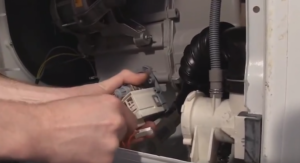
- turn off the power to the machine;
- turn off the water supply tap;
- remove the garbage filter (according to the rules described above);
- look into the resulting hole. Ideally, there should be nothing there except the impeller. If there are foreign objects or lumps of debris, remove them;
- remove the powder receptacle from the housing;
- cover the floor with a blanket and carefully place the washing machine on its right side;
- remove the pan, if equipped;
- take a photo of the wiring diagram for the drain pump;
- disconnect the wiring;
- loosen the clamps holding the drain pipe and hose on the element body;
- pull the pipes off the pump;
- remove the pump from the machine;
- clean the impeller of debris and entangled hair;
- pry up the special latches to open the body of the part;
- inspect the integrity of the mechanism and rubber gaskets, clean out any accumulated dirt.
If the drain pump was clogged, then after cleaning the machine may start working again. Therefore, assemble the part, put it in place, connect the removed hoses and disconnected wires.
When no debris is found in the pump, you will have to check the electrical part. For this you will need a multimeter. The tester is switched to voltage measurement mode, its probes are applied to the pump contacts. If a zero or one appears on the device screen, it means the motor is “burnt out” and the part will need to be replaced.
Testing the engine
The engine, tachogenerator and brushes will have to be viewed through the bottom. And since the pump was checked before, it means that the washing machine is in the desired position, on its side, and the drain pump and pipe are disconnected. Therefore, the next stage of diagnosis will be to disconnect the wiring from the motor, unscrew the bolts securing it and remove the element.
To easily pull out the engine, push it back, pull it down slightly, and then pull it towards you.
Having taken out the motor, find the Hall sensor on it. Outwardly it looks like a ring. Disconnect the part and test with a multimeter. If everything is fine with the tachogenerator, remove the electric brushes and inspect them. If there is obvious wear on the graphite rods, replace the pair.
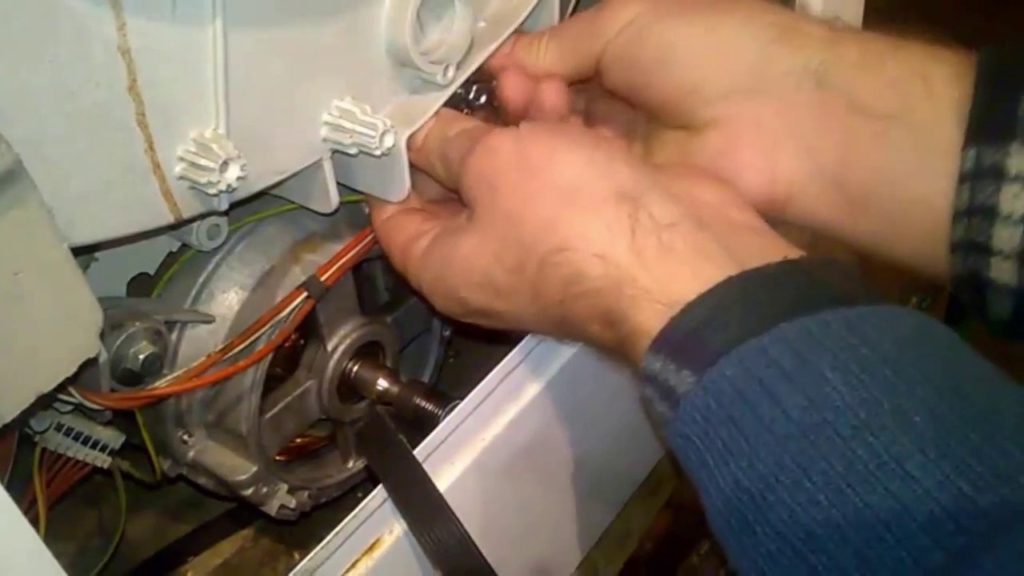
If new brushes are not required, use a multimeter to check the resistance of the stator and rotor windings of the motor. Having identified a malfunction, you will have to decide what is more appropriate: replace the unit or buy a new machine.
"Brain" of the machine
Fortunately, the main unit of Kandy washing machines very rarely fails. But if all possible causes have been ruled out, you will have to check the electronics. Probably, it is the control module that is “to blame” for the fact that the washing machine does not spin out or drain the water.
The main problem is that it will not be possible to get close to the module, much less perform its diagnostics, without experience and skills. In this case, it is better to invite a master. A knowledgeable specialist will check the control board and give recommendations for equipment repair. Of course, you will have to pay for the services, but this is better than completely breaking the “brain” of the washing machine due to an illiterate inspection.
Getting into the electronics of a washing machine on your own is risky and can only make the situation worse.

Now it’s clear what to do if the Candy washing machine suddenly stops and cannot drain the water from the tank, start spinning. First of all, you need to “empty” the unit and check the elements of the drain system for blockages. Next, a more complete diagnosis is performed: the drive mechanism is inspected, the motor and tachometer are tested. In most cases, you can fix the breakdown yourself, but you will still have to call a technician to repair the control module.
Interesting:
Reader comments
- Share your opinion - leave a comment
Categories
Washing machine repair


For buyers

For users

Dishwasher

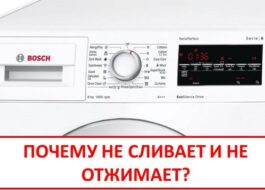
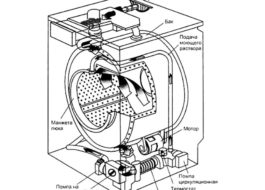

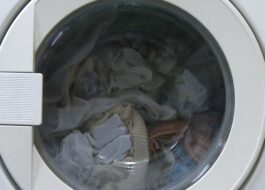

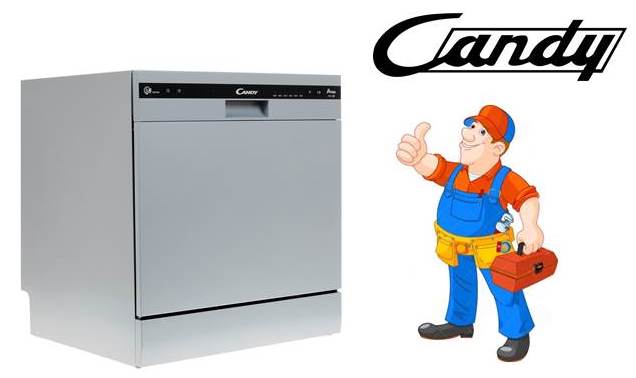










Add a comment